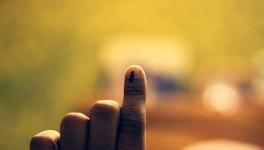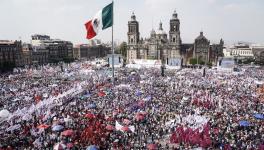What Kind of War is Ukraine Fighting?
The Russia-Ukraine conflict is four months old. Its first phase involved quick Russian armoured manoeuvres on multiple fronts deep inside Ukrainian territory. Ukrainians responded with small-arm mobile tactics that inflicted a good amount of damage. Surprisingly, unlike the full-scale, full-spectrum American invasion of Iraq, the Russians did not advance on major cities they had surrounded. In April, they even withdrew their largely intact forces.
The second phase of the war is concentrated in the eastern and southern regions bordering Russia. Unlike the enveloping and on-and-off character of the first phase, the second phase has localised and intense artillery battles without breaks. With much success, Russians have adopted the strategy of surrounding and destroying, one by one, the entrenched defensive positions of the Ukrainians in the Donbas region.
The Ukrainians are doggedly fighting for every kilometre. In many places, earlier in Mariupol and now in Severodonetsk, even when localised defeat is imminent, they do not evacuate. Instead, they push in even more forces. To lay observers, this kind of fightback for every inch of land could appear to be fervent patriotism. The sentiment of patriotism, however, does not fully explain why the Ukrainians are following a tactic that amounts to deliberate destruction of their armed forces and, at most, achieves the delay of the Russian advance by a few days.
The Ukrainians admit their casualty rate, of both the wounded and those killed in action, is around one thousand per day. The actual damage may be even higher. By comparison, the total Indian casualties in the Kargil war were about 1,800 and about 12,000 in the 1971 war. The Ukrainian armed forces of 2,00,000 are one-sixth of the Indian troops and cannot sustain such heavy losses for an extended period.
In this scenario, a rational Ukrainian strategy would be to fall back and concentrate the core of their armed forces in locations that are difficult to surround, from where they can launch successful counter-attacks at opportune moments or force a stalemate. Retreat in the face of a stronger enemy is an honourable war tactic. Russians used it most famously in the Battle of Borodino in 1812 while facing Napoleon’s invasion. They retreated beyond even Moscow, letting Napoleon occupy the city. But in the end, the Russians destroyed his Grande Armée, and their victory sealed their position on the European ‘Great Powers’ chessboard.
Politics of War
According to Carl von Clausewitz, war is a continuation of policy by other means, yet these ‘other means’ are not separate from politics. The conduct of war is not determined solely by the principles of warfare but also by reasons of politics. To this day, western propaganda describes the 1968 Tet Offensive by the Vietnamese against the American occupiers and their supporters as a defeat of North Vietnam. Far from this, it showed the Americans they could not win the war. Within a month of the offensive, the American president told his people he would sue for peace and stop bombing North Vietnam. If America continued its war for seven years after the writing on the wall was clear and expanded to bombing Laos and Cambodia, it was due to the politics of imperialism. Like all imperial powers, America wanted to show the world it would extract the maximum cost from anyone unprepared for peace on American terms. It still dictates the politics of the conduct of war by itself and its NATO allies in Yugoslavia, Iraq, Afghanistan, Libya, and Syria.
The Ukrainian war in Donbas appears to be determined by two factors. One is the inability of the ruling elite to accept the fact they are losing. This is connected to how the ruling elite and Ukrainian-speaking majority imagine Ukraine as a nation. The second factor is the integration of this war into NATO’s competition with Russia, which puts different strategic demands than a sovereign country would opt for.
The first factor—inability to accept loss—is surprising, as Ukraine has gone through eight years of civil war. During this time, about one-third of the area of Donbas, the country’s industrial heartland, was outside the control of the Kyiv government. The Minsk Agreements of 2015 were, in fact, the result of this reality. We can find the reason for the failure to acknowledge losses on the battlefield and follow a rational tactic in the nation-making myths of Ukraine. One myth many scholars note is the idea of ‘two Ukraines’, one made up of nationalist Ukrainians and the other of Russian-speaking Ukrainians who are suspect in nationalist eyes. The second is the myth of an “Other”, namely Russia, which is seen as a historical enemy of the Ukrainian nation. The Nazi wing of the Ukrainian right-wing sees Russians in racial terms—not as Slavs but as a Finno-Urgic Asiatic horde. The Russian president’s myth of an expansive Russian history, in which Ukrainians appear as Little (brothers of) Russians, further inflames Ukrainian passions.
The hatred of Russia and ethnic Russian Ukrainians by nationalist Ukrainians is not a primordial sentiment but of recent origin. The critical flashpoint was the events in 2014, which are alternatively seen as the Maidan revolution or Maidan coup by either side in the civil war. The Ukraine of 1991 was a multi-ethnic, multi-lingual, heterogeneous social formation. Many ethnic Ukrainians spoke Russian at home. There are many examples of how at moments of political instability, such societies quickly split along religious, linguistic or ethnic lines and degenerate into violent infernos. Right-wing political elites jockeying for quick gains in a fluid situation play a crucial role. India’s Punjab of 1947 is the nearest example of this phenomenon. A significant refrain running through many oral memories of that conflagration is the absence of anticipation of violence. Yet violence did occur despite an integrative, progressive nationalist mobilisation in the form of the Indian freedom movement.
As the political economy of neoliberalism has spread in the past forty years and progressive movements have lost ground, we see such splits and violence erupt in many countries, from Yugoslavia to Libya, Syria, Iraq and Sudan. Even the so-called established liberal democracies like the United States and India have seen right-wing politics consolidate around race and religion.
Since unified national formations in the periphery can potentially challenge western imperial domination, the latter is ever-ready to add fuel to the fire and exploit any ethnic, religious, or linguistic divides. Yugoslavia and Libya are burning examples of imperial machinations, where they turned on the dirty western game of encouraging one supranationality against another as soon as the existing state structures showed cracks. Western imperialism plays a similar role in Ukraine, with even more gusto due to Ukraine’s geopolitical location next to Russia. The ‘Ukrainian’ part, centred around Kyiv, has been projected as an emerging and benign democracy. It has been sold dreams of milk and honey of joining the European Union and the iron protection of NATO, while the separatist Donbas republics in the eastern part have been demonised as Russian puppets.
We can understand Ukrainian military actions in Donbas in light of Ukrainian national myths of betrayal by Russian-speaking Ukrainians and the othering of Russia. In the framework of these myths, defeat by Russia is not just a military setback but puts the very existence of the Ukrainian nation under threat. Manic resistance, even if counterproductive in the long run, appears to be the only option. Euphoria over the seeming successes of Ukraine in the first phase of war also makes it difficult to accept setbacks in Donbas.
Imperial Embrace
Ukrainian actions on the battlefield are also guided by the politics of Western imperialism. NATO countries have publicly declared their aim in this war is to humiliate and weaken Russia. They cannot directly fight nuclear-powered Russia. However, if Ukraine goes down fighting, that perfectly fits their purpose. Much of Ukraine’s heavy war material at the beginning of the conflict has been destroyed. It is now crucially dependent upon weapons supplied by NATO countries. According to one report, in the last week of May, the United States was giving Ukraine military support worth $135 million daily. At this rate, in one year, the United States alone would provide military aid of $50 billion, comparable to Russia’s total defence budget of $60 billion and nine times the $5.4 billion defence budget of Ukraine in 2021.
These numbers are not directly comparable, for the United States will retain a good part of its military aid as profits of its military-industrial complex and fees for its trainers. Furthermore, western military equipment is highly expensive compared with Russian and erstwhile Ukrainian weapons. Nevertheless, these figures show how dependent the Ukrainian military is upon Western sources.
In terms of state finances, too, Western aid is essentially bankrolling the Ukrainian government. The G7 countries have allocated to it $19.8 billion as financial assistance, which is one-third of the $56 billion revenue of the Ukraine government in 2020. The $40 billion aid package approved by the United States Congress includes $8 billion to help “the Ukraine government continue to function”.
Given these facts, we cannot analyse Ukraine’s war effort in isolation from the interests of NATO countries. Preserving the Ukrainian army to leverage it for an honourable peace later would be in the interests of a sovereign Ukraine but would not serve the interests of NATO. The latter is eyeing a campaign similar to the Afghan Mujahideen’s against the Soviets: a long-duration conflict of ceaseless attrition.
The popular hold of nation-making myths about Ukraine and NATO’s plan to bog Russia down explain the seemingly irrational behaviour of the Ukrainian armed forces on the battlefield. However, the peripheral location of Ukraine to Europe-centred imperial capital means this strategy cannot go too far. As the collapse of the Ashraf Ghani regime after the Americans withdrew from Afghanistan showed, in the neo-liberal era, the nationalist commitments of ruling elites in peripheral countries are shallow.
The Ukraine of 2022 is, obviously, very different from the Afghanistan of 2021. It has a reasonably sound economic base, even if controlled by a kleptocratic rump bourgeoisie more interested in siphoning off than creating wealth, and bound by anti-Russia nationalist ideology. Nevertheless, the more Ukraine gets integrated as a ‘frontline’ state in the war of western imperialism against Russia, the more it will become a client state. Its industry will lose to more efficient western capital, and its skilled workforce and workers would end up as migrant workers in western Europe. It will degenerate into a dependent social formation, like some Balkan countries, provided Russia does not stretch itself and occupies only Russian-speaking areas where it has local support and where not many Ukrainians will be prepared to go and fight. NATO will always find a few Azov Battalion-type Nazi group members ready for terrorist activities in those regions. After the phase of active war, the NATO and the Ukrainian forces will be, at most, limited to cross-border shelling. And that would hardly be the ‘war’ NATO and Ukrainian nationalists are looking for.
The author teaches physics at St Stephen’s College, Delhi. The views are personal.
Get the latest reports & analysis with people's perspective on Protests, movements & deep analytical videos, discussions of the current affairs in your Telegram app. Subscribe to NewsClick's Telegram channel & get Real-Time updates on stories, as they get published on our website.
























